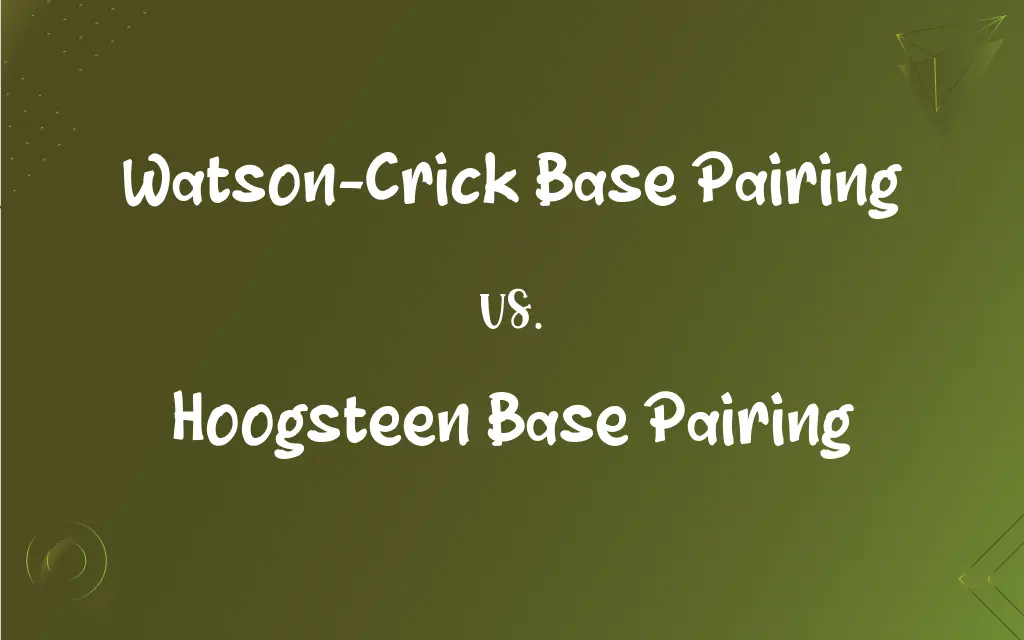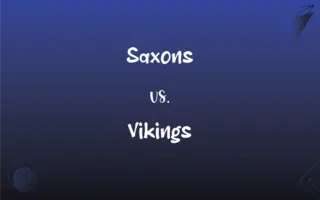Watson-Crick Base Pairing vs. Hoogsteen Base Pairing: What's the Difference?
Edited by Aimie Carlson || By Harlon Moss || Published on February 4, 2024
Watson-Crick base pairing involves standard A-T and G-C pairs in DNA; Hoogsteen base pairing involves alternative hydrogen bonding, often in damaged or modified DNA.

Key Differences
Watson-Crick base pairing is characterized by adenine (A) pairing with thymine (T) and guanine (G) with cytosine (C) via hydrogen bonds, forming the standard DNA double helix. Hoogsteen base pairing, in contrast, involves alternative hydrogen bonding patterns, where A can pair with T or G, and C can pair with G in a different orientation.
Watson-Crick base pairing is the predominant form in normal, healthy DNA under physiological conditions. Hoogsteen base pairing occurs less frequently, often in response to DNA damage, high proton concentration, or the presence of certain proteins and ligands.
Watson-Crick base pairing is fundamental to DNA replication and transcription, ensuring genetic fidelity. Hoogsteen base pairing, though less common, plays a role in DNA repair processes, gene regulation, and the structure of DNA complexes with proteins and other molecules.
The Watson-Crick model offers stable and predictable base pairing, crucial for the structural integrity of DNA. Hoogsteen base pairing, while less stable, provides flexibility and adaptive responses to DNA damage or structural modifications.
Watson-Crick base pairing was discovered by James Watson and Francis Crick, revolutionizing the understanding of DNA structure. Hoogsteen base pairing, named after Karst Hoogsteen, was identified later and has expanded the understanding of DNA complexity and adaptability.
ADVERTISEMENT
Comparison Chart
Base Pairing
A-T, G-C through standard hydrogen bonds
Alternative hydrogen bonding patterns
Typical Occurrence
Normal, undamaged DNA
DNA under stress, damage, or with proteins
Role in Biology
DNA replication, transcription
DNA repair, regulation, complex structures
Stability and Predictability
High stability, predictable
Less stable, adaptable
Discovery and Research
James Watson and Francis Crick, 1953
Karst Hoogsteen, later discovery
ADVERTISEMENT
Watson-Crick Base Pairing and Hoogsteen Base Pairing Definitions
Watson-Crick Base Pairing
Watson-Crick base pairs are held together by hydrogen bonds.
Hydrogen bonds in Watson-Crick base pairing ensure genetic fidelity.
Hoogsteen Base Pairing
Hoogsteen base pairing involves alternative hydrogen bonding in DNA.
Hoogsteen base pairing occurs in certain DNA-protein interactions.
Watson-Crick Base Pairing
Watson-Crick base pairing is a fundamental concept in genetics.
Understanding Watson-Crick base pairing is crucial for studying genetics.
Hoogsteen Base Pairing
Hoogsteen base pairs are less common but biologically significant.
The study of Hoogsteen base pairing helps in understanding DNA under stress.
Watson-Crick Base Pairing
Watson-Crick base pairing forms the standard structure of DNA.
The stability of the DNA double helix is due to Watson-Crick base pairing.
Hoogsteen Base Pairing
Allows flexibility and adaptability in DNA structure.
Hoogsteen base pairing contributes to the dynamic nature of DNA.
Watson-Crick Base Pairing
Involves adenine pairing with thymine, and guanine with cytosine.
DNA replication relies on the precise Watson-Crick base pairing.
Hoogsteen Base Pairing
Plays a role in DNA repair and gene regulation.
Hoogsteen base pairing is involved in complex DNA repair mechanisms.
Watson-Crick Base Pairing
It is essential for accurate DNA replication and transcription.
Errors in Watson-Crick base pairing can lead to genetic mutations.
Hoogsteen Base Pairing
It can occur under physiological stress or DNA damage.
DNA damage can lead to the formation of Hoogsteen base pairs.
FAQs
What is Hoogsteen base pairing?
Alternative hydrogen bonding patterns in DNA.
What is Watson-Crick base pairing?
Standard A-T and G-C hydrogen bonding in DNA.
How are Watson-Crick and Hoogsteen base pairs different?
They differ in hydrogen bonding patterns and conditions of occurrence.
Where is Watson-Crick base pairing commonly found?
In normal, healthy DNA.
Why is Watson-Crick base pairing important?
It's essential for DNA replication and maintaining genetic fidelity.
Are Watson-Crick base pairs more stable than Hoogsteen pairs?
Yes, they are more stable and predictable.
Does Watson-Crick base pairing occur in RNA?
RNA usually involves A-U and G-C pairing, following similar principles.
Is Watson-Crick base pairing involved in genetic disorders?
Errors in this pairing can lead to genetic mutations and disorders.
Who discovered Hoogsteen base pairing?
It was named after Karst Hoogsteen.
In what conditions does Hoogsteen base pairing occur?
Under stress, DNA damage, or with certain proteins.
Who discovered Watson-Crick base pairing?
James Watson and Francis Crick in 1953.
What triggers Hoogsteen base pairing in DNA?
Environmental stress, protonation, or interaction with proteins and ligands.
Can Hoogsteen base pairs form in healthy DNA?
Rarely; they usually occur under special conditions.
What is the biological role of Hoogsteen base pairing?
Involved in DNA repair, regulation, and complex structures.
How does Hoogsteen base pairing affect DNA structure?
It introduces flexibility and adaptability.
How do Watson-Crick base pairs contribute to DNA’s double helix structure?
They form the stable ladder-like rungs of the double helix.
Can Hoogsteen base pairing lead to mutations?
It's more related to DNA repair, but abnormalities can potentially cause mutations.
Is Watson-Crick base pairing reversible?
Yes, during DNA replication and repair.
How is research on Hoogsteen base pairing advancing genetics?
It provides insights into DNA behavior under various conditions and its adaptability.
Are Hoogsteen base pairs reversible?
They can be, depending on the DNA's state and conditions.
About Author
Written by
Harlon MossHarlon is a seasoned quality moderator and accomplished content writer for Difference Wiki. An alumnus of the prestigious University of California, he earned his degree in Computer Science. Leveraging his academic background, Harlon brings a meticulous and informed perspective to his work, ensuring content accuracy and excellence.
Edited by
Aimie CarlsonAimie Carlson, holding a master's degree in English literature, is a fervent English language enthusiast. She lends her writing talents to Difference Wiki, a prominent website that specializes in comparisons, offering readers insightful analyses that both captivate and inform.






































































